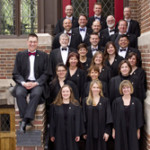St. Martin’s Chamber Choir: Celtic Echoes
A review by Robin McNeil
Friday evening, February 7, I attended the St. Martin’s Chamber Choir performance entitled, Celtic Echoes. The program consisted of British Folksongs and Partsongs, several of which would be easily recognized by most concertgoers. Among those were Greensleeves, Loch Lomond, and Irish Tune From County Derry.
It may be helpful for some of you readers to understand exactly what a partsong is. The term partsong refers to a homophonic style wherein the upper voice carries the melodic line. Think of a four-part choral composition with S (soprano), A (alto), T (tenor), and B (bass). In a partsong, the soprano usually has the melodic line, but it is also possible for the tenor or the altos to sing the melodic line; however, only one melodic line is sung at a time. The term partsong is the antonym of Madrigal wherein there is a polyphonic (contrapuntal) treatment of the melody, which is repeated at regular intervals in each voice of the choir. Remember your days of youth, sitting around a campfire, and singing Row, Row, Row, Your Boat. That is a simple example of counterpoint – the melodic line is repeated at specific intervals.
Maestro Timothy Krueger and the St. Martin’s Chamber Choir began the performance with the well-known English folk song Greensleeves. This particular arrangement was done by W. H. Anderson (1882- 1955), an Englishman who settled in Canada, and arranged a vast amount of folksongs from many countries. This particular arrangement was, in some ways, traditional, but had moments of twentieth century harmonies and deceptive resolutions of the harmony. It was beautiful, and the performance of the choir was stunning because of its dynamic range which immediately caught my attention, as well as their precision in pitch and phrase entrances and exits. The performance of this opening folksong set the tone for the entire performance of the evening. The text of this arrangement was a love poem: the program did not say who wrote the poem, if indeed, it is known. You must understand that the folk music of Renaissance England, as separated from the art music of the time, was performed by balladeers, minstrels, and other musicians who simply performed the music but were not skilled enough to compose it. There were large amounts of ballad texts which were instantly written (and occasionally printed) with the only direction given that they should be sung to the melody of such folksongs as Greensleeves. There has been some discussion about the first written appearance of this folksong because it appears in Thysius Lute Book (c. 1595) and the Fitzwilliam Virginal Book which contains music from 1562 to 1612. The only reason I bring this up is to demonstrate the popularity of this still-relevant piece of music, as the aforementioned Lute Book was a Dutch publication.
The choice of arrangement demonstrates the musicological skill of Dr. Timothy Krueger. Most of the music performed Friday evening has been collected by the twentieth century’s most valuable English musicians and collectors, among them: W. H. Anderson, Ralph Vaughn Williams, R. O. Morris, Gustav Holst, Peter Warlock, Granville Bantock, and Percy Grainger (Australian). Many of the folksongs that were performed Friday had several arrangers, but Krueger has the depth of knowledge to pick the best. He also possesses the musicianship to put together a choral organization in which, I am convinced, every member could be a soloist. I will also make the editorial comment that there should have been more young people in the audience. After all, the text of these folksongs concern topics that would be of interest to young people (love, the loss of love, lullabies, nature, etc.). And, unlike modern pop performances, St. Martin’s Chamber Choir has such remarkable diction, that every word could be understood, which seems to be an amazing concept in today’s pop music performances.
There is absolutely no question that the poignancy of Friday evening’s performance was created not only by the text of the songs, but by the artful interpretation by the choir. The folksong, The Turtle Dove, was the second work on the program, and the text concerns the statement of eternal love by a young man to his ‘bonny lass.’ This work was arranged by Ralph Vaughn Williams, and it was exquisite. Each member of the choir seemed to be emotionally involved with the text as well as the music, and the performance was spellbinding. That kind of involvement by each member of the choir is what sets this organization apart from many others. One could ascribe this to ‘detail’ work, but that sounds so sterile after hearing the performance. For example, one of the works performed Friday evening was the Irish Tune From County Derry, which many of you readers will know under the name of Danny Boy. The St. Martin’s Chamber Choir sang this arrangement by Percy Grainger without any text whatsoever, and it was just as moving as the rest of the program which had text. It was quite a surprise to hear this popular melody sung without words because it certainly highlighted the beauty of the melody as well as the outstanding ability of the choir. Though many have long ascribed this folksong as a statement of eternal love between a man and a woman, most are now in agreement that it represents the statement of a father’s loss of his son in battle.
Yarmouth Fair, arranged by Peter Warlock, was a cheerful description of a celebration. Blow Away The Morning Dew was the accounting of a winsome young lady who makes her amorous boyfriend appear as a fool in front of her father.
Though the program had a subtitle of British Folksongs and Partsongs, it was divided between the English, Welsh, Irish, and Scottish folksongs. One of the most beautiful of the evening was An Cronan Bais, which is Scots Gaelic (Erse is the form of Gaelic in Ireland, Cymric in Wales) for The Death Croon. Though it was arranged by Granville Bantock who died in 1946, many of the harmonies seemed more recent. I am quite sure that this is a very old folksong, undoubtedly from the pagan era of the Outer Hebrides. However, the text, as performed Friday evening, was decidedly from the Christian era. This is only given as a point of interest, but it helps to underscore the varied impact that this performance by the St. Martin’s Chamber Choir had on Friday evening’s audience.
Brett Kostrzewski, is the Conducting Intern for St. Martin’s, and I must say that in his conducting of some of the folksongs Friday evening, that he achieved the same results as Timothy Krueger. Miles Canaday, likewise, achieved the same results. Canaday is the conductor of the MSU Denver Women’s Chamber Choir, who will appear with St. Martin’s Chamber Choir on Saturday and Sunday’s performance.
Soloists at the Friday evening performance were Taylor Martin, tenor; Marjorie Bunday, contralto; and Leslie Remmert Soich, contralto. All three of these soloists have excellent vocal production which, in turn, allows them excellent diction. Every word could be understood, and their phrasing, as well as their musicality, was superb.
The St. Martin’s Chamber Choir, under the direction of Maestro Timothy Krueger, is one of the most outstanding choral organizations, not only in Colorado, but in the United States. I always marvel at how their performances can be so stunning and consistently fine. I spent many hours, which were required of piano majors at my undergraduate school, accompanying in voice studios, and every member of this choir exemplifies what the voice professors were telling their students. I am continually amazed that there are so many fine vocalists in Denver. There was a decent audience Friday evening, but to my way of thinking, Holy Cross Lutheran Church should have been standing room only for this performance.









